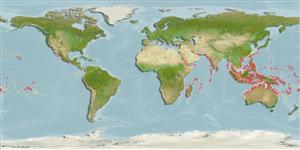>
Syngnathiformes (Pipefishes and seahorses) >
Syngnathidae (Pipefishes and seahorses) > Nerophinae
Etymology: Choeroichthys: Greek, choiros = a pig + Greek, ichthys = fish (Ref. 45335).
More on author: Bleeker.
Environment: milieu / climate zone / depth range / distribution range
Ökologie
seewasser riff-verbunden; tiefenbereich 2 - 25 m (Ref. 30874). Tropical; 30°N - 30°S
Indo-Pacific: Red Sea and East Africa to the Society Islands, north to the Philippines and Guam, south to northern Australia.
Size / Gewicht / Alter
Maturity: Lm ? range ? - ? cm
Max length : 7.0 cm TL Männchen/unbestimmt; (Ref. 30874)
Rückenflossenstacheln (insgesamt) : 0; Rückenflossenweichstrahlen (insgesamt) : 18 - 26; Afterflossenweichstrahlen: 4. Dark brown with parallel of small black spots in series along trunk, and some white speckles (Ref. 48635).
Occur on the continental shelf (Ref. 75154). Found in tide pool, seagrass, and coral reef areas. Ovoviviparous (Ref. 205). The males carry the eggs in a brood pouch which is found under the tail (Ref. 205). Males may be brooding at 3.5-4.0 cm SL (Ref. 5316). Also found in lagoons and seaward reefs (Ref 90102).
Life cycle and mating behavior
Geschlechtsreife | Fortpflanzung | Ablaichen | Eier | Fecundity | Larven
Male carries the eggs in a brood pouch (Ref. 205).
Dawson, C.E., 1985. Indo-Pacific pipefishes (Red Sea to the Americas). The Gulf Coast Research Laboratory Ocean Springs, Mississippi, USA. (Ref. 5316)
IUCN Rote Liste Status (Ref. 130435: Version 2024-1)
Bedrohung für Menschen
Harmless
Nutzung durch Menschen
Fischereien: nicht kommerziell
Tools
Zusatzinformationen
Download XML
Internet Quellen
Estimates based on models
Preferred temperature (Ref.
123201): 26.1 - 29.3, mean 28.5 °C (based on 3058 cells).
Phylogenetic diversity index (Ref.
82804): PD
50 = 0.5156 [Uniqueness, from 0.5 = low to 2.0 = high].
Bayesian length-weight: a=0.00093 (0.00036 - 0.00242), b=3.05 (2.83 - 3.27), in cm total length, based on LWR estimates for this (Sub)family-body shape (Ref.
93245).
Trophic level (Ref.
69278): 3.4 ±0.5 se; based on size and trophs of closest relatives
Widerstandsfähigkeit (Ref.
120179): hoch, Verdopplung der Population dauert weniger als 15 Monate. (Preliminary K or Fecundity.).
Fishing Vulnerability (Ref.
59153): Low vulnerability (10 of 100).
Nutrients (Ref.
124155): Calcium = 250 [126, 623] mg/100g; Iron = 1.5 [0.7, 2.8] mg/100g; Protein = 17.7 [16.3, 19.2] %; Omega3 = 0.121 [0.053, 0.289] g/100g; Selenium = 46.2 [16.7, 125.3] μg/100g; VitaminA = 59 [15, 228] μg/100g; Zinc = 3.01 [1.75, 4.75] mg/100g (wet weight);
